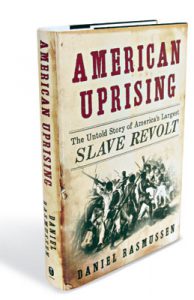“If heads on poles were symbols of control, they were also symbols of the ritual violence that was the constant underlying element of Louisiana society.”
—Daniel Rasmussen, “American Uprising: The Untold Story of America’s Largest Slave Revolt.”
This column is a little late for Black History Month, but it still has an important story to tell. We often forget that a very large number of American immigrants did not choose to come to this country and they were never paid for their work.
In 1810 nearly one third of the population of the southern states (1.1 million) was African slaves. By 1860 their portion had increased to one half as their numbers rose to 3.2 million. 
As historian Daniel Rasmussen states: “Slavery built New Orleans, slavery built the south, slavery built much of the economic wealth that today we see in America.” By 1820 New Orleans had become the largest slave market in America and it played a pivotal role in tripling the number of slaves in the Southern States. Rasmussen reminds us that cotton was America’s largest export even in the 1930s.
The sugar plantations of Louisiana were veritable death camps for African workers, who made up 75 percent of the population. The average life span of a cane cutter was seven years. Unlike slaves elsewhere in the South, overworked sugar workers did not reproduce well enough to replace themselves, so the owners simply bought more and more slaves.
Writing about the Cuban plantations in his book Sugar is Made with Blood, historian Robert Paquette states that “it was cheaper to work field slaves to death in five years and replace them by purchase than to see to their long-term maintenance and reproduction.” Historian Roderick McDonald reports that in Jamaica the sugar cultivators “died faster than they bore progeny.”
Most of us take the meaning of “sold south” or “sold down the river” as slaves being auctioned off to just any Southern farmer. What it actually meant was being sent to the sugar plantations of Louisiana. As Rasmussen states: “Nowhere in America was slavery as exploitative or were profits as high. Slaves worked longer hours and faced more brutal punishments than any other slave society in North America.”
Given their brutal conditions it is no wonder that the African cane cutters around New Orleans rose up on January 8, 1811. The rebels had planned well: their masters would be hung over from their all-night Carnival parties; the American army was in Baton Rouge fighting the Spaniards; and recent heavy rain and knee-deep mud would prevent the movement of artillery.
Louisiana was not yet a state, and French and Spanish culture dominated the scene. A French activist had been arrested for speaking out about human equality, and documents from the French Revolution were found among the rebels’ possessions. As Rasmussen explains: “These slaves were politically aware. They were sophisticated and they knew what they were doing.”
Upwards of 500 Africans, armed with cane knives and muskets captured from plantation armories, marched on New Orleans, then defended by only 68 troops. Had it not been for the lucky escape of planter Manuel Andry, the black rebels may well have succeeded.
Andry’s farm was the first one attacked and he managed to flee across the Mississippi and was able raise a force of well-armed plantation owners. They attacked the rebels from the rear and routed them, leaving 40-60 dead on the field and suffering no casualties. In the end only two whites were killed, one of them Andry’s son.
A vicious campaign of retaliation then began. The rebel leader was hunted down in the swamps, and they, as Rasmussen describes it, “shot him in both thighs, chopped off his limbs, and then burned him alive.” About 100 rebel corpses were then decapitated and their heads were displayed on poles all along the River Road northwest of New Orleans.
At the time many said that the Africans had it coming, and that even white on white violence was common for frontier society. However, 21 American newspapers reprinted an editorial in the Louisiana Courier condemning the beheadings as excessive and barbaric: “Civilized man ought to remember well his standing, and never let himself sink down to the level of savage.”
American officials, Louisiana planters, and their descendants made sure that most of us would not know anything about the largest slave uprising in American history. We have Daniel Rasmussen to thank for uncovering one of the most violent events in our dark, racial history.